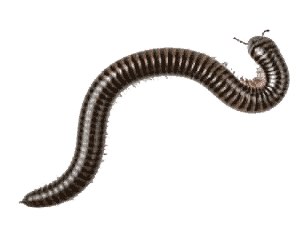We Are Millipede Exterminators
EnviroPest has been protecting local homes and families for over 30 years. Our millipede exterminators provide a variety of treatments including our all-natural millipede bug control solutions that effectively deal with your issue without requiring you to leave the comforts of your home for more than a few hours.
Our Industry Leading Millipede Extermination Method
We Start with a Thorough Investigation
As a household pest, millipedes are more of an annoyance or nuisance, rather than an indoor-breeding pest that causes destruction. Millipedes normally are found outdoors where they feed on damp and decaying wood, organic material, and will also feed on tender roots and green leaves that have fallen to the ground. This occasional invader has two pair of legs per body segment (as compared to the centipede, which has one pair per segment,) except for the first three segments which have one pair of legs per segment. Generally, millipedes over winter in the soil near the foundations of homes, green houses or other structures. Homes are invaded (sometimes in huge numbers) either after heavy rainfall (spring through fall) or when searching for a site to over winter. For some unknown reason, millipedes at times become restless and leave the soil to crawl into houses. This is most common with homes that have ground-level patio doors, basements or other areas that are easily accessible.
Millipede bugs can be an especially tricky pest. There is a good chance that your infestation is not confined to one room in your house. They start from the outside of a structure and breed excessively in high moisture areas. Areas around foundations where the concrete meets the soil and excessive moisture areas around mulch and landscaping can make for high breeding areas. Our technicians have the experience and expertise to understand all the possible hiding spots for millipede bugs and thoroughly inspect each possible location.
Our Treatment Tool-Chest
We offer a variety of different treatments for millipede extermination and will provide recommendations on which procedure is right for your pest situation.
We promise you a 100% millipede-free house, and we guarantee it! If you find that some of those pesky bugs managed to get past our initial assault, we will come back and make sure we treat your house again free of charge.
Call Today! (855) GET-ENVIRO
Who To Hire
What to Look for When Hiring a Millipede Exterminator
- The pest management company should be licensed by the state and insured.
- Technicians should be certified pest management professionals and fully licensed in the state.
- The company should be a member of a professional organization, such as the National Pest Management Association.
- The company should have a staff entomologist or access to one.
- Technicians should have experience with millipede control.
- Choose a company based on their quality of service, not the price. Research user reviews and testimonials to solidify your choice.
- A pre-inspection should be conducted to assess the scope of the work.
- The proposed work should follow the steps of integrated pest management, not just pesticide application.
Our Guarantee
Complete Service Guarantee
If at any time between services or your guarantee period, you as a customer of EnviroPest are not satisfied for any reason. We will readdress the area in question at no additional charge. We have serviced over 300,000 homes and businesses over 30 years, and our clients rely on us to stand behind the work we perform.
Our continuous inspection and treatment mean a 100% guarantee as long as you have us on the property.
Our service personnel has been trained and certified with over six (6) years of experience in the pest control field as specialists. We do not advocate or provide seasonal labor or “college kids” to provide applications in or around your family or home. Another reason we are the natural choice in pest control.
ASK THE EXTERMINATOR:
How Serious Are Millipedes? Are They Dangerous?
Millipedes do not bite or sting, nor do they do any damage to stored food, structures, or furniture. However, there are some species of millipede that excrete a defensive fluid that irritates the skin of people who handle them or otherwise come into contact with those toxic millipede species.
Since the pests are most active at night, their appearance can scare homeowners moving boxes or other items. Millipedes also move in large numbers, so they can become a major nuisance and cause quite a fright to unsuspecting people or pets. But, since millipedes feed on and thus decompose organic matter, they are actually very beneficial to the environment.
How Did I Get Millipedes?
They usually dwell in damp areas outdoors but can migrate inside if their habitat outdoors becomes too hot and dry.
Entry Points
When they come to a home, millipedes gather on porches and patios. They climb the foundation of the home and they often find entryways such as:
- Basement doors and windows
- Crawlspace vents
- Doors with missing weather stripping
- Garage door
Millipedes usually live outside in damp areas under mulch, leaves, compost piles, flowerpots, boards or stones. However, they may wander into your house by mistake or in search of water during periods of drought or in need of shelter when heavy rains drive them from their natural habitat, causing an infestation in your home, basement, crawl space or garage.
If you have a heavy millipede infestation in your house, there are likely millipedes breeding in your lawn or under mulch, leaf litter or debris near your foundation.
Preventing millipedes from entering your home is the best approach to millipede control. Stephen Cameron, Head And Professor Entomology at Purdue University says to remove mulch, leaves, grass clippings, boards or woodpiles, stones, boxes and similar items that are on the ground next to your foundation, as these items attract millipedes. If you can’t remove an item, raise it off the ground.
Here are a few other ways for how to get rid of millipedes:
- Remove moisture from foundation or crawl space.
- Use properly functioning gutters, down spouts and splash blocks to keep water away from your foundation wall. If your house has poor drainage, you may need to install tiles or drains or slope the ground so water drains away from your foundation.
- Repair leaky faucets, water pipes and air conditioning units.
- Adjust your sprinkler system to minimize water pooling on your lawn.
- Reduce humidity in your crawl space or basement by providing adequate ventilation, sump pumps and/or polyethylene soil covers.
Millipedes also thrive in the moist thatch layer of poorly maintained lawns. De-thatch your lawn and mow the grass short to make it less appealing to millipedes. Avoid over-watering or watering your yard at night to keep millipedes at bay.
Seal cracks and openings in your outside foundation. Here are a few suggestions for how to best accomplish this:
- Apply thresholds or tight-fitting door sweeps at the base of all exterior doors.
- Caulk the sides and bottom outside edge of door thresholds.
- Seal expansion joints where patios, sun rooms and sidewalks are next to your foundation.
- Inside your house, seal expansion joints and gaps along the bottom of your basement walls.
Should We Apply Pesticide for Millipedes?
A trained EnviroPest management professional will know best how to apply and how to kill millipedes with insecticide. To kill millipedes, apply insecticides to these outdoor areas:
- Along the bottom of exterior doors
- Around crawl space entrances
- Around foundation vents and utility openings
- Up underneath siding
- Along the foundation, in mulch and plant beds; be sure to rake back mulch and leaf litter to expose the millipedes’ hiding places
- A few feet up the base of the foundation wall
Applying insecticide along the interior foundation walls of your damp crawl space or unfinished basement may also help with millipede control. EnviroPest can easily take care of this for you.
Wait it out. Millipedes can only live for a few days in the dryness of your house, so your millipede infestation will be short-lived.
- Remove potential food sources and habitats from in and around your home.
- Millipedes curl up into a tight coil when they are disturbed or dead. You can just pick them up with your vacuum or broom.
How Does EnviroPest Handle Millipedes?
EnviroPest is trained to manage millipedes.
- Inspection – Millipede treatment usually begins with an inspection by your pest management professional to locate the source how the pests are getting inside the home. Once the inspection is completed, your technician will prepare a plan that may involve both non-chemical and chemical treatment methods.
- Prevention – Non-chemical components of the plan will emphasize preventing the pests from getting inside the home and reducing suitable habitats. Some specific actions include sealing around doors, windows, cracks, gaps, and crevices, plus reducing moist places that promote millipede survival. For example, the plan may recommend limiting the amount of mulch, rocks, or debris that are likely to create moist areas favoring large numbers of millipedes.
- Removal – If chemical products are the most effective and efficient approach, your plan might include exterior and interior applications of products to potential entry points and harbor-age sites where millipedes accumulate.
You can also use the onsite chat feature, Free Pest Inspection form on this page, or our online contact form to get in touch with us. Whatever your pest control need, we are happy to help you eliminate it.
Featured Product Lines:

We have used EnviroPest for many years and HANDS DOWN, they are top-notch. Any issues that come up they address immediately. The EnviroPest technician was very informative and did a very thorough job. We would recommend this company to anyone!






